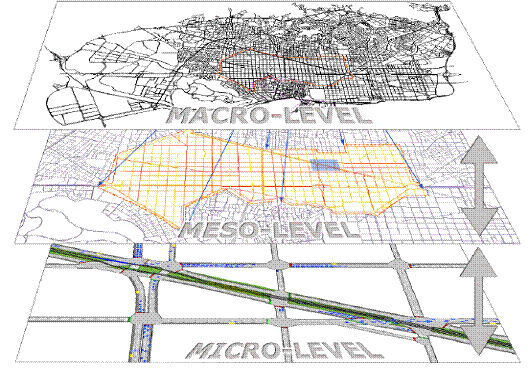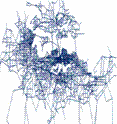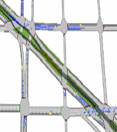2.0 Existing AMS Tools
At the outset of this effort, existing candidate ICM AMS tools were evaluated and compared for their ability to model ICM strategies; and for their input/output interface, usability, modeling features, and calibration requirements. Findings from this evaluation reveal that existing models share certain common features, but vary widely in their implementations and data requirements. Most existing tools do not fully integrate the representation of transit services with other auto-based traffic flow and facilities. Also, most of these tools are designed to model recurrent congestion conditions. Modeling non-recurrent congestion conditions requires integration with macroscopic travel demand models and possibly other special modeling techniques. Further, model computational scope, efficiency, and complexity are often closely related to the model resolution.
For the purposes of this evaluation, existing analysis tools were split in three general categories, including travel demand models, mesoscopic simulation models, and microscopic simulation models. Figure 2.1 presents a graphical depiction of the geographic scope and interrelationships between these tools.
Figure 2.1 Geographic Scope in Existing Traffic Analysis Tools

Definitions and assessments of these tool categories are provided here:
- Travel Demand Models – Predicting travel demand requires specific analytical capabilities, such as the consideration of destination choice, mode choice, time-of-day travel choice, and route choice, as well as the representation of traffic flow in the highway network. These attributes are found in the structure and orientation of travel demand models; these are mathematical models that forecast future travel demand from current conditions, and future projections of household and employment characteristics. Travel demand models were originally developed to determine the benefits and impacts of major highway improvements in metropolitan areas. Today, travel demand models are used in more wide-ranging tasks, including development of transportation master plans, evaluation of proposed land-use changes, initial design of transportation facilities, evaluation of air quality impacts, and assessment of future transportation needs. However, these tools were not designed to evaluate travel management strategies, such as ITS, ICM, and operational strategies. Travel demand models have only limited capabilities to accurately estimate changes in operational characteristics (such as speed, delay, and queuing), resulting from implementation of these operational strategies. These inadequacies generally occur because of the poor representation of the dynamic nature of traffic in travel demand models. Examples of travel demand modeling tools are CUBE, TransCAD, and EMME/2.
- Microscopic simulation models – Microscopic simulation models simulate the movement of individual vehicles, based on theories of car-following and lane-changing. Typically, vehicles enter a transportation network using a statistical distribution of arrivals (a stochastic process); and are tracked through the network over small time intervals (e.g., one second or fraction of a second). Typically, upon entry, each vehicle is assigned a destination, a vehicle type, and a driver type. In many microscopic simulation models, the traffic operational characteristics of each vehicle are influenced by vertical grade, horizontal curvature, and superelevation, based on relationships developed in prior research. The primary means of calibrating and validating microscopic simulation models is through the adjustment of driver sensitivity factors. Computer time and storage requirements for microscopic models are fairly large, usually limiting the network size and the number of simulation runs that could be completed. Because of the detailed representation of the traffic network found in these models and because of their ability to model traffic control strategies (such as ramp metering or traffic signal pre-emption), these tools are well-suited for modeling ICM strategies such as accommodating/promoting cross-network diversions. Examples of microscopic simulation models are VISSIM, Paramics, and AIMSUN.
- Mesoscopic simulation models – Mesoscopic models combine properties of both microscopic and macroscopic simulation models. As in microscopic models, the mesoscopic models’ unit of traffic flow is the individual vehicle, and they assign vehicle types and driver behavior, as well as their relationships with the roadway characteristics. Their movement, however, follows the approach of macroscopic models and is governed by the average speed on the travel link. Mesoscopic model travel prediction takes place at an aggregate level, and does not consider dynamic speed/volume relationships as reflected in queue lengths and the temporal distribution of congestion. As such, mesoscopic models provide less fidelity than microsimulation tools, but are superior to travel demand models, in that, mesoscopic models can evaluate dynamic traveler diversions in large-scale networks. Examples of mesoscopic simulation models are Dynasmart‑P, Dynasim, Transmodeler, and Dynameq.
Existing ICM AMS tools were evaluated for their ability to model ICM operational strategies, including information sharing/distribution; improving operational efficiency at network junctions and interfaces; accommodating and promoting cross-network diversions; and managing corridor demand and/or modifying capacity. Detailed definitions of ICM approaches and strategies are available in the ICM web site in the Phase I documents.
Table 2.1 presents a summary comparison of travel demand models, microscopic simulation models, and mesoscopic simulation models. Table 2.2 presents a summary evaluation of existing analysis tools’ ability to model ICM strategies.
Table 2.1 A Comparison of Existing Traffic Analysis Tools
Parameter |
Travel Demand Models |
Mesoscopic |
Microscopic |
|---|---|---|---|
Geographic Coverage |
Regional network/ |
Subregional network |
Small subarea networks |
Demand |
Static O-Ds |
Time-dependent O-Ds |
Dynamic O-Ds |
Traffic Control |
No signal setting or geometric information needed |
Approximate signal settings and phasing schemes needed |
Detailed signal settings and phasing schemes needed |
Analysis |
User equilibrium based on volume-delay functions |
User equilibrium based on simulation-based dynamic traffic assignment |
Behavioral modeling based on car-following of individual vehicles |
Advantages |
Available from local MPO; can analyze mode shift |
Can analyze subregional dynamic diversion |
Can analyze operational strategies, such as ramp metering and traffic signal coordination |
Limitations |
Not sensitive to operational strategies; not capable of analyzing regional dynamic diversion |
Fairly new in the traffic analysis business; not capable of analyzing mode shift |
Limited in geographic scope due to computational and calibration complexity |
Table 2.2 Summary Evaluation of Existing Analysis Tools’ Ability to Model ICM Strategies
Ability to Model ICM Approaches and Strategies |
Microscopic Simulation Models |
Mesoscopic Simulation Models |
Travel Demand Models |
ICM AMS Desired Capabilities |
|---|---|---|---|---|
Information sharing/distribution |
The specific tool is much less capable of analyzing the relevant ICM strategy. |
The specific tool is less capable of analyzing the relevant ICM strategy. |
The specific tool is not capable of analyzing the relevant ICM strategy. |
The specific tool is capable of analyzing the relevant ICM strategy. |
Improve operational efficiency of network junctions and interfaces |
The specific tool is capable of analyzing the relevant ICM strategy. |
The specific tool is less capable of analyzing the relevant ICM strategy. |
The specific tool is not capable of analyzing the relevant ICM strategy. |
The specific tool is capable of analyzing the relevant ICM strategy. |
Accommodate cross network route shifts |
The specific tool is less capable of analyzing the relevant ICM strategy. |
The specific tool is capable of analyzing the relevant ICM strategy. |
The specific tool is much less capable of analyzing the relevant ICM strategy. |
The specific tool is capable of analyzing the relevant ICM strategy. |
Accommodate cross network modal shifts |
The specific tool is much less capable of analyzing the relevant ICM strategy. |
The specific tool is not capable of analyzing the relevant ICM strategy. |
The specific tool is less capable of analyzing the relevant ICM strategy. |
The specific tool is less capable of analyzing the relevant ICM strategy. |
Response to congestion pricing |
The specific tool is much less capable of analyzing the relevant ICM strategy. |
The specific tool is less capable of analyzing the relevant ICM strategy. |
The specific tool is much less capable of analyzing the relevant ICM strategy. |
The specific tool is capable of analyzing the relevant ICM strategy. |
In summary:
- Every tool type represents a tradeoff between geographic scope and level of resolution (scale vs. complexity). Less detailed tool types are tractable for large networks, while more detailed tool types are restricted to smaller networks. Depending on corridor size and the types of analyses required, all tool types are potentially valuable for ICM AMS.
- Microscopic and mesoscopic simulation models are capable of modeling traveler information strategies, while travel demand models do not have this capability. However, the limited geographic scale of microscopic simulation model implementations makes them less effective choices for traveler information evaluations that involve more than just changeable message signs. The most significant trip choices are made pre-trip or very early in longer trips, and mesoscopic simulation models are more effective than other tool types in evaluating pre-trip and en-route traveler information. Desired capabilities in ICM AMS are more than the capabilities found in existing tools.
- “Improve operational efficiency…” refers to system optimization strategies, such as freeway ramp metering and arterial traffic signal coordination. Microscopic simulation models are effective at analyzing these strategies. Mesoscopic simulation models are less effective, and travel demand models do not have this analysis capability.
- Travel demand models are better than other existing tools in estimating mode shift, but microscopic and mesoscopic simulation models are better at estimating route shifts. In fact, mesoscopic tools can estimate regional dynamic diversion of traffic, while microscopic tools can estimate route shift at a smaller geographic scale. Also all travel demand models are capable of analyzing mode-shift, while this capability is very limited in macroscopic simulation models and non-existent in mesoscopic simulation models.
- Finally, mesoscopic simulation tools are better at analyzing traveler responses to congestion pricing, but the ICM AMS desired analysis capability is more than what is offered by existing tools.



